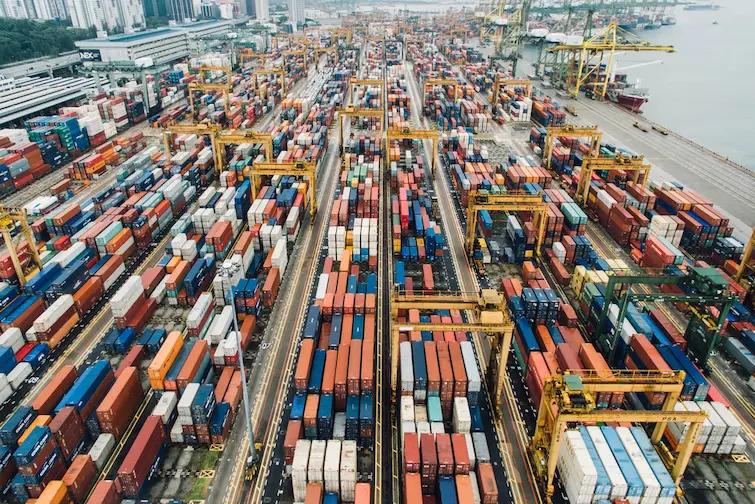
Grocery shortages became commonplace during the pandemic, as everything from toilet paper to chicken was in short supply. Naturally, shoppers presumed that with the reopening, all would return to normal in their supermarket. It’s easy to imagine the “off” switch being turned to “on” and things simply picking up where they left off for grocers.
As we’ve all seen, such expectations were wildly optimistic. The news today is full of images of supply-chain mayhem: the container-ship traffic jam off the Port of Long Beach and in San Pedro, California, and containers stacked in every possible spot ashore. Trucks loaded with containers clog the area’s residential streets, as neighbors fume and truck drivers plead for understanding.
And at the other end of the chain, there’s a container shortage, as those delayed containers aren’t returning quickly enough to ports in Asia.
The huge, stimulus-fueled surge in demand that came in 2021 blindsided most retailers, suppliers, and manufacturers. The USDA reports that demand for food is up 13% over 2020, accounting for part of our food shortages.
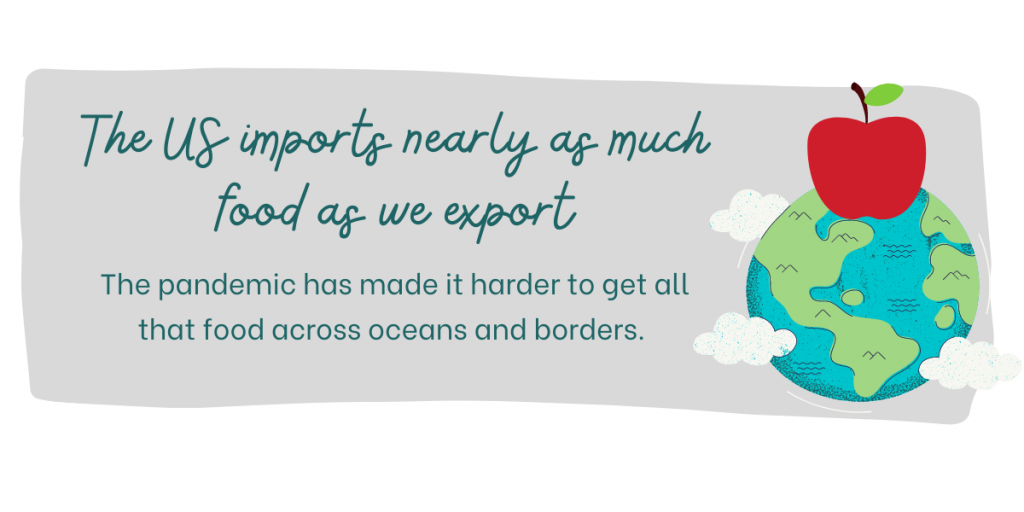
Store shelves have been emptied of a wide range of items across a broad array of categories, including chicken tenders, cream cheese, pet food, pumpkin, turkey, and more. Panic buying has returned and grocers have been forced to reinstate purchase limits on popular items.
“I never imagined that we’d be here in October 2021 talking about supply-chain problems, but it’s a reality,” Vivek Sankaran, chief executive officer of Albertsons Cos., told Bloomberg. “Any given day, you’re going to have something missing in our stores, and it’s across categories.”
Empty Shelves
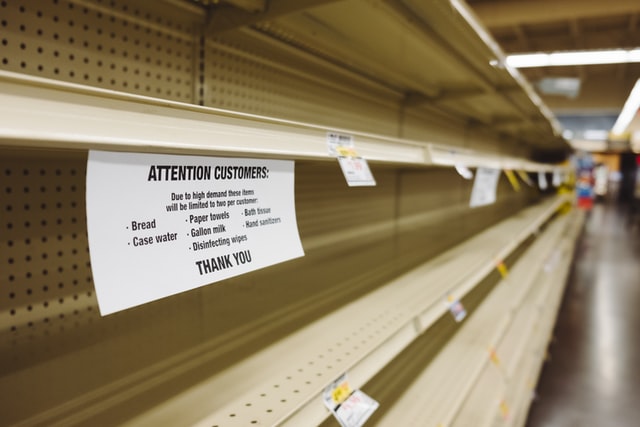
While there are not widespread “food shortages” in the strict definition of the term, much of the food being produced is not getting to where it needs to go quickly enough. For example, dairies are producing plenty of milk, but driver shortages are making it hard to get it all to market.
Food industry logistics are a hot mess–in some cases, quite literally. Containers full of tomatoes on a ship stranded offshore fermented to the point of explosion, leaving decks awash in tomato sauce.
Alcohol producers are still trying to catch up from America’s 2020 stay-at-home drinking binge, but liquor takes a long time to produce, costs a great deal to import, and usually comes in currently-hard-to-source glass bottles. Meat-packing plant production has slowed due to Covid outbreaks, new workplace safety rules, and a catastrophic ransomware attack on a major processing plant. That’s led to a shortage of beef.
And Thanksgiving turkeys? Anyone who waited until November to buy theirs may be out of luck.
The list goes on. Reports Amrita Thakkar in her article, 7 Things You Might Not Find in Your Grocery Store (And Why), “last year, people stocked up on canned goods—and manufacturers wound up facing an aluminum shortage. The shortage has continued over a year into the pandemic, leading to reduced supply of products like tomato paste, canned vegetables and soda.”
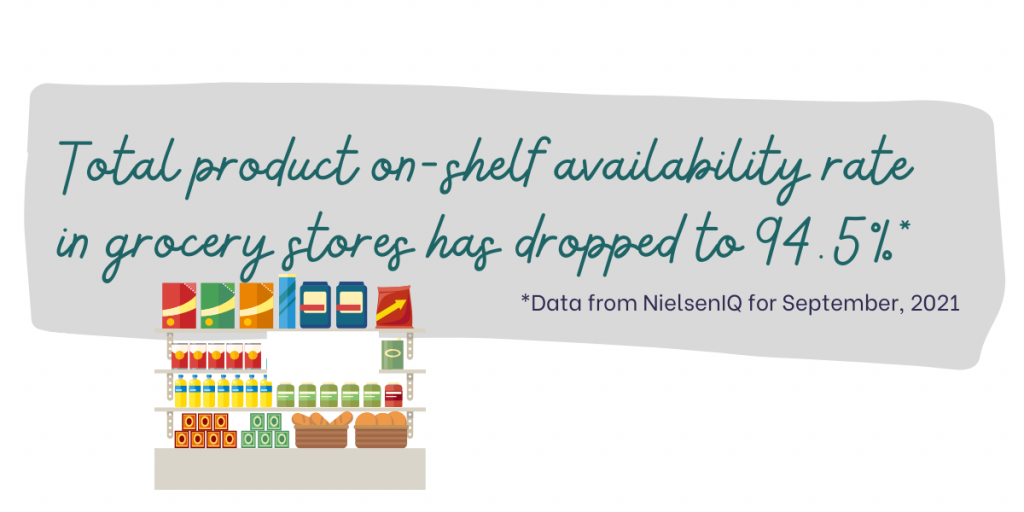
Indeed, conditions are so bad in some UK grocery stores that cardboard cutouts featuring photographs of food are being used to make empty shelves look less bleak–much to the delight of social media.
Explains Jim Dudlicek, a representative for the National Grocers Association, “There simply aren’t enough people to make the goods, move the goods and sell the goods.”
The Supply Chain: Too Lean?
While the Covid-19 pandemic was the cause of this “black swan” disruption, the vulnerability of our supply chain has been tying experts in knots for years. The supply chain is really a supply network: a complex, interdependent web of companies that provide everything from shipping to labor.
“Americans are habitually unattuned to the massive and profoundly human apparatus that brings us basically everything in our lives,” writes Amanda Mull in an article in the Atlantic.
That is until we go to the grocery store and discover we can’t purchase Lunchables.
Some have blamed the massive supply chain seize-up on the practices of lean management, codified in the Six Sigma management practices employed by over half of Fortune 500 companies. Critics cite the lean strategy of “just in time” (JIT) inventory management as leaving the supply chain weak and vulnerable to delays and disruption.
The just-in-time inventory system is a management strategy that synchronizes raw-material orders from suppliers directly with production schedules, according to Investopedia. By using this inventory strategy, companies can increase efficiency and decrease waste by receiving goods only as they need them for the production process, thereby reducing inventory costs.
But true JIT requires producers to accurately predict demand.
In an article about supply chain woes, Bloomberg reported that “Saffron Road, a producer of frozen and shelf-stable meals, is holding extra inventory, keeping about four months of supply on hand instead of the typical one or two months.”
Alas, no one forecasted the massive drop in demand that Covid precipitated. And few accurately forecasted the massive spike in demand that would follow “re-opening” in the US.
Outsourcing to Ouch-Sourcing
As tempting as it is to lay supply chain blame at the feet of JIT, other experts believe it’s probably more accurate to blame outsourcing, which has created much longer and more complex supply chains.
Almost half the goods imported into the US come through two ports: the Port of Los Angeles and the Port of Long Beach. Shipments passing through these ports are now routinely delayed by weeks as ships wait offshore to be unloaded.
Even during normal times, it takes 1-3 business days to unload a container ship, which may be carrying 10,000 containers.
And it’s not just consumer electronics, clothing, and cars. That maritime traffic jam is impacting supermarket shelves.
For example, most of the concentrate used for apple juice manufacturing in the US now comes to us from China. Snack food, tea, spices and fresh or processed fruits and vegetables comprise nearly half the agricultural commodities we import from China.
“When you have longer, slower, less reliable supply chains—you need more inventory,” explains Mark Graban in his Lean blog. And inventory was exactly the thing that manufacturers didn’t want during the pandemic.
As demand plunged, warehouses emptied and companies slowed or shut down production lines. When demand spiked abruptly this year, retailers and their suppliers were caught flat-footed. It’s hard to restart a production line quickly when you’ve laid off the workers you need to run it. Labor shortages will continue to be a factor in our supply chain woes.
Of course, shipping cheap products from overseas only works if the shipping itself remains cheap. But the cost of shipping a container has spiked, going from $2,000 to $5,000 per container to $30,000 ($20,000 if you’re willing to wait awhile).
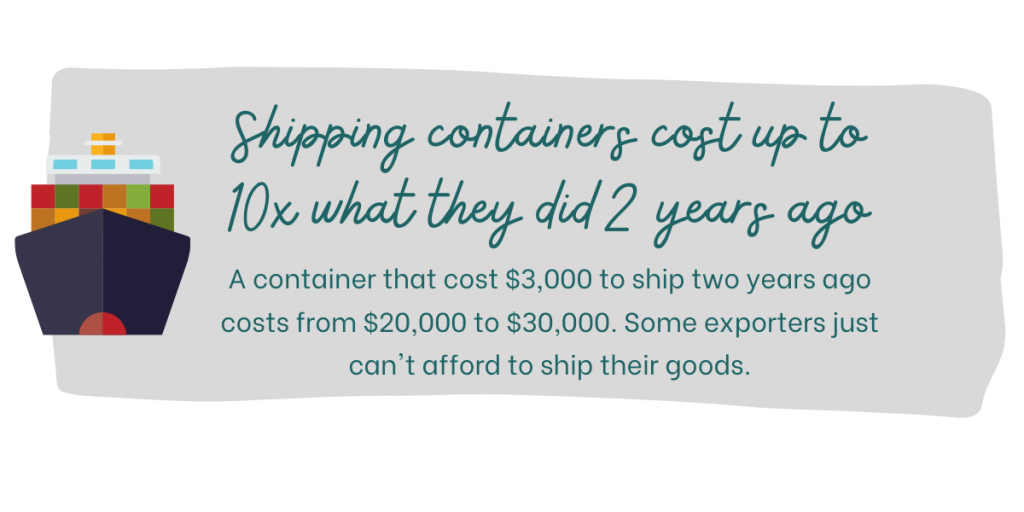
One of the principal reasons for this is that many Asian countries producing inexpensive products for export are still grappling with Covid and the more infectious Delta variant. Major shipping ports in China have been closed due to infection-prevention measures. Vietnam and Malaysia have vaccination rates in the low single digits. These countries have had to reduce manufacturing capacity and are unable to adequately staff container ports.
Some manufacturers and exporters have decided to sit out this turbulent phase, rather than do business at a loss.
But a root cause of the mayhem is a longtime, systemic problem. According to an article in the Washington Post, ports in the United States “operate as separate fiefdoms rather than as part of a national system.” Foreign ports are decades ahead of the US in utilizing software that enables carriers, terminals and shippers to share data that makes forecasting and planning more efficient.
Voila! More shortages.
Watch this fascinating video that breaks down why there’s a shortage of so many products
Trucked Up
Well before the Coronavirus pandemic, the US had a serious shortage of truck drivers. Chronic low wages and challenging working conditions have made it difficult to recruit enough drivers.
Worse yet, trucking companies don’t want to deal with ports. Only a small number of trucks possess the registration, tags, and driver certifications required to service ports.
Then there’s the specialized chassis required to carry a shipping container–chassis which are also in short supply. Grueling conditions and long waits mean that drivers who are paid by the load may end up making well below minimum wage.
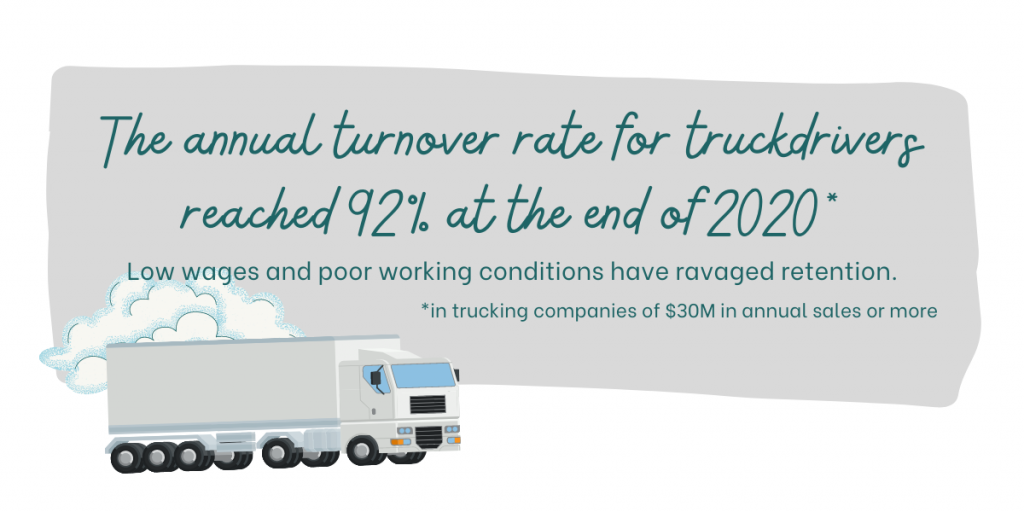
In his Medium blog, 20-year veteran trucker Ryan Johnson described what it’s like to deliver and pick up freight at a port, where a handful of enormous cranes must load and unload thousands of containers from dozens of ships:
Think of going to the port as going to WalMart on Black Friday, but imagine only ONE cashier for thousands of customers. Think about the lines. Except at a port, there are at least THREE lines to get a container in or out. The first line is the ‘in’ gate, where hundreds of trucks daily have to pass through 5–10 available gates. The second line is waiting to pick up your container. The third line is for waiting to get out. For each of these lines the wait time is a minimum of an hour, and I’ve waited up to 8 hours in the first line just to get into the port.
Johnson isn’t optimistic that things will improve quickly; without significant improvements in compensation and benefits, he’s convinced trucking companies will be unable to meet the challenge.
Even for trucking companies not dealing with the ports, delays are a fact of life. It’s also harder to cross borders now, thanks to travel restrictions put in place to slow the spread of the virus.
More Broken Links in the Chain
The nation’s food packing and processing jobs are largely filled by immigrants and visiting workers. Thanks to poor and often dangerous working conditions, the impact of Covid-19 on these communities has been devastating. The workforce has been decimated by infections, deaths, and the departures of workers unwilling to continue in such high-risk jobs.
In many facilities, implementation of distancing and other safety protocols has reduced the number of workers on the floor, slowing production further.
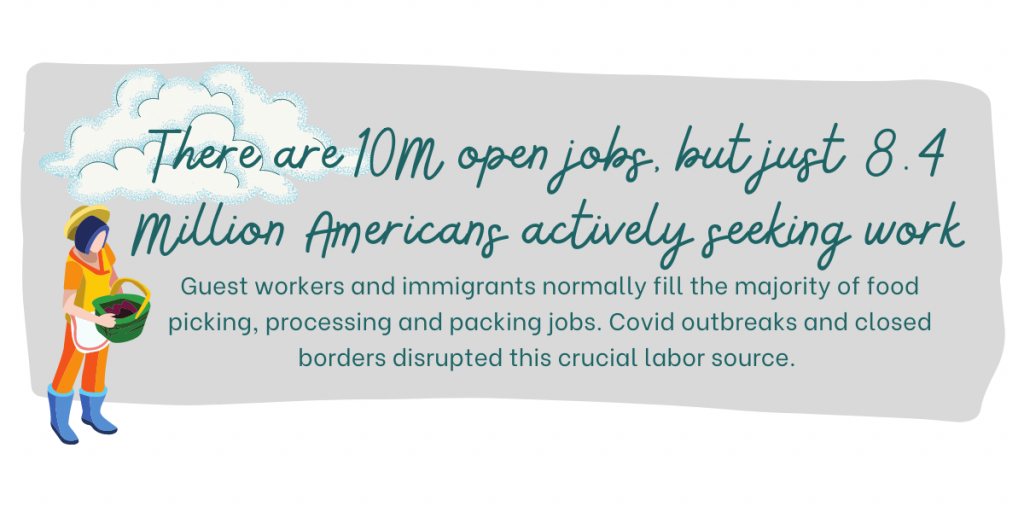
Low staffing levels have hit every link in the grocery supply chain, including the final one: food retailers themselves. As grocery stores struggle to recruit enough employees, it’s becoming more challenging to make sure that product gets on the shelves and (finally!) into customers’ shopping baskets.
Many workers are now wary of taking front line, public-facing jobs, worried that new variants or new viruses could make such work hazardous once again. Others are concerned about a wave of aggressive and inappropriate behavior by customers. This is all putting an upward pressure on wages.
Repairing the Chain
Our food supply chain was weak and brittle before the pandemic. It’s the result of years of squeezing more and more “efficiency” from a woefully out-of-date system that is simultaneously becoming more complex, thanks to technology.
Repairing it will take time and (you guessed it!) money. We’ll need a wide array of initiatives for each disrupted link.
- Labor shortages will likely be relieved by market forces, as employers increase wages and improve working conditions in an effort to attract and retain enough workers. Many businesses will be forced to undergo a serious reckoning as their overhead increases, and much of this will be passed along to consumers in the form of higher prices.
- Greater collaboration and transparency among the different players in the supply chain will help prevent future logjams. US Ports need to modernize, implementing software that enables carriers, shippers, and terminals to share data. So far, only the Port of New Orleans is even testing such a platform.
- Without enough American citizens to fill open jobs, immigration quotas and policies will need to be updated. Notes Nicole Narea of Vox, “The US needs roughly 10 million people, including low-wage and high-skilled workers, to fill job openings nationwide — and only 8.4 million Americans are actively seeking work.” In a normal year, she says, “the US welcomes roughly 1 million immigrants, and roughly three-quarters of them end up participating in the labor force. In 2020, that number dropped to about 263,000.”
- Infrastructure, including sea ports and railroad ports, will require massive upgrades. Currently the US is the world’s #2 exporter, but ranks #10 in the world for access to quality ports. (Rotterdam, Singapore, and the UAE boast the top three most modern and well-equipped ports.) The recently passed infrastructure bill should help kick-start this process.
- The US can increase its resilience by on-shoring more companies in industries critical to economic health and food security. As the real cost of outsourcing is understood, incentives can be created to ensure we have adequate domestic production capacity. Buying domestic (and local) while conserving agricultural lands will help ensure that we have the food we need.
While our supply chain is currently having a moment in the spotlight, that moment will inevitably pass.
Mastering the grocery supply chain is a long game. We can’t afford to return to the myopic, short-term thinking that got us here.
This is our moment to restock our shelves with optimism, ingenuity, and determination. Because every big crisis comes equipped with an equally big opportunity.
Summary
The COVID-19 pandemic exposed vulnerabilities in the US grocery supply chain, leading to widespread grocery shortages. Disruptions occurred at multiple points: shipping delays at ports, container shortages, labor shortages in trucking and food processing, and challenges in predicting consumer demand. Lean management strategies like Just-In-Time (JIT) inventory compounded the issue. Solutions include improving labor conditions, modernizing US ports with shared data platforms, reshoring critical industries, and investing in infrastructure to build a more resilient and flexible supply chain.
Key Takeaways on Grocery Supply Chain Disruptions
- Grocery shortages became commonplace during the pandemic, affecting everything from chicken to toilet paper.
- US imports were delayed by port congestion, container shortages, and surges in demand.
- Labor shortages across trucking, food processing, and retail exacerbated supply chain disruptions.
- Lean inventory practices, particularly Just-In-Time, left the supply chain vulnerable to sudden demand spikes.
- Outsourcing production overseas increased complexity, delays, and reliance on global shipping.
- Shipping costs surged dramatically, creating additional strain on retailers and consumers.
- Systemic weaknesses in US port operations, infrastructure, and labor policies amplified shortages.
- Solutions involve modernizing infrastructure, reshoring critical industries, improving labor recruitment and retention, and increasing collaboration and transparency among supply chain participants.
Frequently Asked Questions
Q. Why are grocery shortages still occurring after the pandemic?
A. Multiple factors: port congestion, container shortages, labor shortages in trucking and food processing, surges in demand, and complex global supply chains.
Q. How did Just-In-Time inventory contribute to supply chain issues?
A. JIT reduces inventory to cut costs, but relies on accurate demand forecasts. When demand spiked unexpectedly, companies lacked the buffer to meet it.
Q. What role did outsourcing play in supply chain failures?
A. Outsourcing extended supply chains, adding dependency on overseas production, shipping, and port efficiency, making the system more vulnerable to delays and disruptions.
Q. How did labor shortages affect grocery supply?
A. Shortages in truck drivers, food processors, and grocery store staff slowed transportation, production, and stocking, worsening product availability.
Q. What can be done to prevent future grocery shortages?
A. Modernizing ports with shared data platforms, investing in infrastructure, reshoring critical industries, improving labor conditions and recruitment, and fostering greater collaboration across the supply chain.
